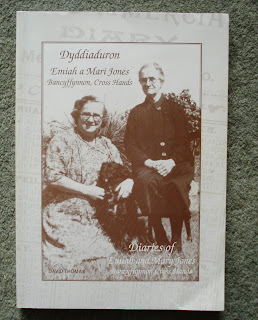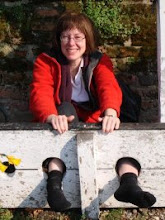
Our BQSG seminar was held at Gregynog - it was formerly the grand house of two sisters, but is now a teaching, seminar and conference centre for the University of Wales. It must have been a large estate, as it was a long drive to the house from the main road.

The view from my bedroom!
 I was cold during the first night - I got up to search for some blankets - here is what I found in the wardrobe - two tapestry blankets! Very warm!
I was cold during the first night - I got up to search for some blankets - here is what I found in the wardrobe - two tapestry blankets! Very warm!
 An amusing sign - I had to investigate -- the other language is obviously Welsh.....
An amusing sign - I had to investigate -- the other language is obviously Welsh.....
 More explanation- not in Welsh this time ...
More explanation- not in Welsh this time ...
 A Victorian W.C. with a manual pump, all hidden under a neat wooden flap...the same in any language...
A Victorian W.C. with a manual pump, all hidden under a neat wooden flap...the same in any language...
Now to the real business....we had some excellent papers. They were all very interesting and well presented. I am looking forward to seeing the next volume of Quilt Studies where the papers will be published.
Kathryn Berenson, who lives in Paris (lucky woman!) gave a paper on Quilted Works of Naples - the French and Italian context of the Tristan Quilts. Very scholarly and lovely illustrations.
Maxine March gave a paper on a red cross quilt now in the Imperial War Museum- The Marchant Grove Quilt. This was a very moving talk in which Maxine related how she tracked down a no longer extant village in Saskatchewan, Canada and made contact with people living in the area. The quilt is embroidered with the names of servicemen, and she was able to track down amay of the families. Many photos were shown, very interesting, this talk was many people's favorite as it was so evocative of the times in which it was made.
Anita Loscalzo gave a talk on two bedcovers which had images of Charlotte Princess of Wales. These are in the New England Quilt Museum.
After tea (excellent food throughout, by the way) we had a talk by Roger Clive-Powell (Jen Jones other half) on quilt photography. I took several photography courses at Smith and I am glad to say that this made me dust off the old brain cells and chimed with what I had learnt all those years ago. Roger photographs the quilts himself. This takes place outside - there was an amusing drawing of a wicked looking cloud emerging over a hill, headed towards the photography set up - an angled board holds the quilt while a tall scaffold holds the photographer and camera. Roger uses a film camera and an instant or light received setting. Later the film images are scanned to digital. I too find that natural light seems to bring up the quilting better than artificial light.
An after dinner talk by Jen Jones was very enjoyable and we saw some wonderful images of Jen's quilt collection.Of course she related the story of the conversion of old Town Hall to Quilt Museum. I was interested to see photos of the quilt storage area - all the quilts are folded flat, as Jen feels that rolling the quilts places stress on the quilting stitches.
Jan Rae gave a very interesting talk on the "Comfy" brand quilt - now known to have been manufactured in Rawtenstall, Lancashire by the British Quilt Company. She investigated records and spoke to former employees. There are still many of these quilts around, I have two myself!
And finally Geoff Crumplin gave a talk on quilt blocks - paper folding was an easy and accurate way of drafting quilt blocks in the days before photographs and .pdfs.
The venue for next years seminar has yet to be fixed - it was to be York, in conjunction with the BQSG exhibition at the Quilt Museum, but as that has been postponed, an alternative has to be found. As there were so many textile producing areas and as there are so many museum collections, it really comes down to finding suitable accommodation, but wherever it may be, I am looking forward to it....
 The front of the quilt in the sage green taffeta. This is a stamped quilt although there are no markings to be seen. There is a large central rose, surrounded by large scrolls and leaves. Crosshatching separates the border of hammocks.
The front of the quilt in the sage green taffeta. This is a stamped quilt although there are no markings to be seen. There is a large central rose, surrounded by large scrolls and leaves. Crosshatching separates the border of hammocks. Central area with the four large scrolls.
Central area with the four large scrolls. There is a corner area of scrolls and leaves that is nicely arranged. The edge is neatly handsewn.
There is a corner area of scrolls and leaves that is nicely arranged. The edge is neatly handsewn. The lime green cotton sateen reverse. You can see that this side has some sun fading along the folds but the quilt appears unused.
The lime green cotton sateen reverse. You can see that this side has some sun fading along the folds but the quilt appears unused.













































